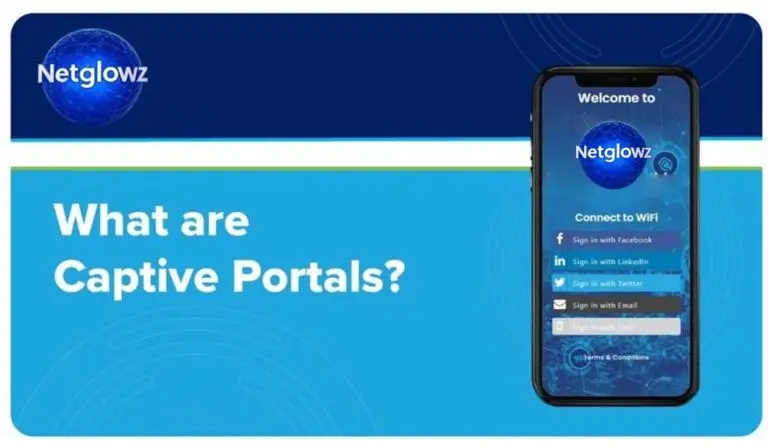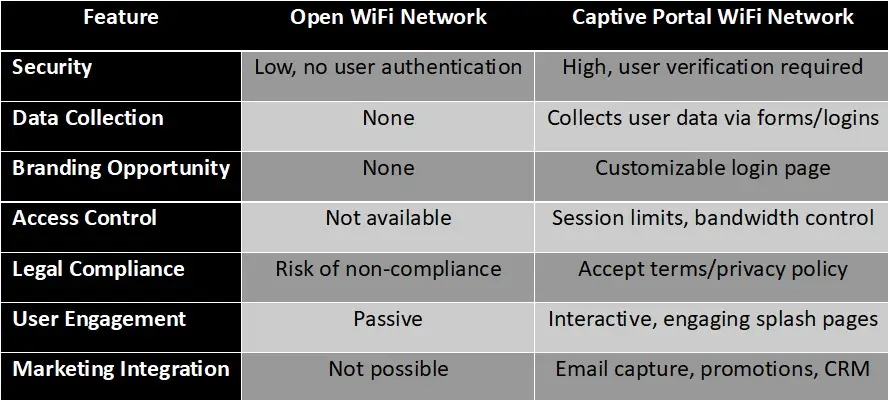WiFi Captive Portals in 2025: Enhancing Connectivity and User Experience
In today’s digital-first world, public and enterprise WiFi networks are expected to deliver not only seamless connectivity but also intelligent user experiences. One of the most effective tools in achieving this is the WiFi captive portal. Whether you’re managing a coffee shop, airport lounge, hotel, or corporate network, captive portals offer the ideal blend of control, security, and user engagement.
In this article, we will explore what WiFi captive portals are, their key benefits, implementation strategies, and best practices to optimize both user satisfaction and network management.
Table of Contents
What is a WiFi Captive Portal?
A WiFi captive portal is a landing page that appears automatically when users join a public wireless network. This page acts as a gateway to internet access, requiring users to complete a specific action before gaining full connectivity. Actions can include accepting terms of service, entering login credentials, signing up with an email address, or even watching an ad.
Captive portals are commonly found in locations like:
- Hotels and resorts
- Airports and train stations
- Restaurants and cafes
- Universities and campuses
- Corporate offices
These portals help
network administrators maintain security, gather user data, and offer
customized user experiences.

Key Benefits of WiFi Captive Portals
1. Improved Network Security
Captive portals create an additional layer of security by verifying users before granting access. This is essential for mitigating unauthorized access, preventing misuse, and reducing the risk of cyber threats.
2. User Data Collection and Analytics
By requiring users to input credentials, sign in via social media, or register with their email, businesses can collect valuable data. This information can be used for marketing campaigns, personalization, and improving services.
3. Brand Visibility and Engagement
The captive portal page can be customized with logos, promotional messages, or advertisements. This offers a unique opportunity to reinforce branding and communicate directly with users at the moment they connect to WiFi.
4. Access Control and Compliance
Network administrators can control access based on user type, session duration, bandwidth limits, and more. Moreover, requiring users to accept terms of service helps ensure legal compliance, especially in countries with strict data regulations.
How to Set Up a Captive Portal
Deploying a WiFi captive portal requires several critical elements to function effectively.
Step 1: Choose the Right Hardware and Software
Verify that your wireless router or access point includes support for captive portal capabilities. Many enterprise-grade devices from vendors like Arista, Cisco, Ubiquiti, Cambium and TP-Link offer built-in captive portal features. Click here to review the complete blog on How to Choose WiFi Router in Pakistan.
Step 2: Configure the Captive Portal Page
Customize the landing page to include:
- Business branding (logo, color scheme)
- Login options (email, social media, voucher, etc.)
- Terms and conditions
- Promotional content or ads
You can use built-in tools, third-party services like Purple WiFi, Cloud4Wi, or open-source solutions such as pfSense and OpenWrt.
Step 3: Integrate with Authentication Services
Captive portals can be integrated with:
- RADIUS servers for centralized authentication
- OAuth for social login (Facebook, Google)
- CRM or email marketing tools like Mailchimp
Step 4: Test and Monitor Performance
Before going live, test the portal across different devices and browsers. After deployment, monitor:
- User login success rate
- Network load and speed
- Data usage patterns
Open WiFi vs Captive Portal WiFi Comparison

Best Practices for Effective Captive Portals
1. Ensure Mobile Responsiveness
With most users connecting via smartphones, your portal page must be mobile-friendly. Use responsive design techniques to ensure fast loading and easy navigation.
2. Keep It Simple and User-Friendly
Avoid cluttering the page with excessive content. Users should be able to access the network seamlessly and without unnecessary obstacles. Limit form fields and provide clear instructions.
3. Offer Multiple Login Options
Allow users to choose from login methods like email, social media, or vouchers. This increases the likelihood of successful connections and data capture.
4. Prioritize Data Privacy
Clearly state your data usage policies. Make sure your setup aligns with data privacy regulations like GDPR, CCPA, and other applicable legal standards. Use secure (HTTPS) connections.
5. Use Time and Bandwidth Limits Wisely
To prevent network congestion, implement session duration and bandwidth restrictions. These limits can also encourage users to upgrade to premium plans.
Use Cases of Captive Portals Across Industries
1. Hospitality
Hotels use captive portals to offer tiered internet packages, promote hotel amenities, and gather guest feedback.
2. Retail
Shopping malls and cafes deploy portals for marketing, customer data collection, and increasing foot traffic through loyalty rewards.
3. Education
Universities and schools use captive portals to ensure authorized access to educational resources and monitor usage.
4. Enterprises
Corporate offices use captive portals for employee access management, security compliance, and visitor tracking.
Tools and Platforms to Create Captive Portals
Popular networking vendors offering built-in captive portal support:
-
Cambium Networks: With cnMaestro controller for centralized management
-
TP-Link: Omada SDN platform supports customizable captive portals
-
D-Link: Nuclias Cloud and D-View 7 include hotspot features
-
Cisco: Meraki and Cisco DNA Center offer enterprise-grade captive portal tools

Conclusion
A well-designed WiFi captive portal can significantly enhance both user experience and network management. By offering secure access, branding opportunities, and actionable insights, captive portals bridge the gap between connectivity and engagement.
Whether you’re a small business owner or an IT administrator, adopting captive portal solutions can unlock new levels of user interaction and operational efficiency.
Frequently Asked Questions | FAQs
1. What is a WiFi Captive Portal?
A WiFi captive portal is a web page that users must view and interact with before accessing the internet on a public WiFi network. It’s commonly used for user authentication, terms acceptance, and data collection.
2. Why should businesses use WiFi captive portals?
WiFi Captive portals enhance security, enable user data collection, improve brand engagement, and help businesses comply with data privacy regulations.
3. Are WiFi captive portals secure?
Yes, when properly configured with HTTPS, user authentication, and integration with secure backend systems like RADIUS servers, WiFi captive portals offer a secure access layer.
4. Can I customize my WiFi captive portal page?
Absolutely. Most platforms, including Cambium, Cisco, TP-Link, and D-Link, allow full customization of the login page with logos, colors, forms, and promotional content.
5. How do users log in through a WiFi captive portal?
Users can log in via OTP ,email, social media, voucher codes, or single sign-on options, depending on the configuration of the captive portal.
6. Do WiFi captive portals work on all devices?
WiFi Captive portals generally support all modern devices including smartphones, tablets, and laptops. However, proper testing on multiple platforms ensures a smooth user experience.
7. Is it legal to collect user data through a WiFi captive portal?
Yes, but it’s crucial to clearly disclose how the data will be used and comply with data protection laws such as GDPR or CCPA.
8. Can I integrate my WiFi captive portal with marketing tools?
Yes, many platforms allow integration with CRMs, email marketing platforms (like Mailchimp), and analytics tools to leverage captured data for marketing purposes.
9. Which vendors offer the best captive portal solutions?
Popular and reliable vendors include Cisco, TP-Link, D-Link, and Cambium Networks. Each offers different features suited to various business sizes and needs.
References
Cisco Captive Portal Configuration Guide
https://www.cisco.com/c/en/us/support/docs/wireless/captive-portal/TP-Link Omada SDN Documentation
https://www.tp-link.com/en/omada-sdn/D-Link Nuclias Cloud and D-View 7
https://www.dlink.com/en/business-solutions/nuclias
https://eu.dlink.com/uk/en/products/d-view-7-network-management-systemCambium Networks cnMaestro Platform
https://www.cambiumnetworks.com/products/management/cnmaestro/Cloud4Wi Captive Portal and Guest WiFi Solutions
https://www.cloud4wi.com/solutions/guest-wifi/
Related posts:
No related posts.

